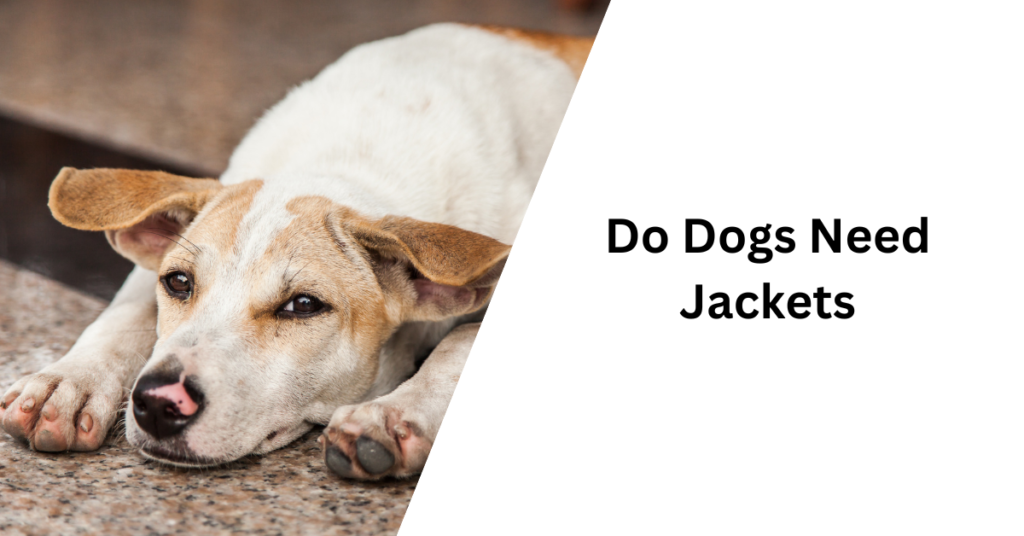Yes, Dogs need jackets in cold weather when temperatures drop below 45°F (7°C), especially for small breeds, short-haired dogs, puppies, and senior dogs. Jackets protect against hypothermia, keep muscles warm, and make outdoor walks safer. Large, double-coated breeds usually don’t need jackets, but wet, windy, or icy conditions increase the need for protection.
When Do Dogs Actually Need Jackets?
Small and thin-furred breeds need extra protection once outdoor temperatures dip to 32°F (0°C). Moreover, as temperatures fall below 20°F (-6.6°C), I recommend monitoring all dogs closely, since even thick-coated breeds can experience discomfort in extreme cold.
Temperature guidelines for different breeds
Different breeds handle cold temperatures uniquely based on their size and coat type. Small dogs under 15 pounds lose heat faster due to their smaller body mass and need protection when temperatures drop below 35°F (1.7°C). Medium-sized dogs between 15-50 pounds, such as Border Collies and Beagles, generally tolerate temperatures around 25°F (-3.9°C).
Larger breeds demonstrate better cold tolerance thanks to their body mass. German Shepherds and Labrador Retrievers stay comfortable around 20°F (-6.7°C), although prolonged exposure below 10°F (-12.2°C) can be dangerous. Double-coated breeds like Alaskan Malamutes, Siberian Huskies, and Saint Bernards come equipped with natural insulation against cold.
Weather conditions to consider
Beyond temperature alone, several weather factors influence your dog’s need for a jacket. A 50-degree rainy day demands different protection than a 35-degree sunny day. For mild temperatures and light rain, a lightweight water-resistant shell suffices, but freezing temperatures or heavy snowfall require well-insulated, waterproof protection.
Strong winds can quickly strip away body heat, making even mild weather feel much colder. This especially affects:
- Senior dogs and puppies
- Small breeds
- Dogs with health conditions
- Less active or calmer dogs
Wet conditions pose additional challenges since soaked fur loses its insulating properties. Rain or snow can completely saturate your dog’s coat, increasing their risk of getting chilled. Additionally, waterproof protection helps keep both your dog and home clean by reducing mud tracking indoors.
Activity level factors
Physical activity significantly impacts how quickly dogs feel cold. Dogs generate substantial body heat during exercise, so an active dog running and playing stays warmer than one walking slowly or standing still. Nevertheless, I suggest keeping outdoor sessions brief – around 15-20 minutes – when the wind chill drops below 20 degrees.
For low-impact activities like casual walks, a lightweight jacket provides sufficient warmth. However, more strenuous activities or extended outdoor time in cold weather require warmer, insulated protection. Senior dogs and those recovering from illness need special consideration since their ability to maintain body temperature may be compromised.
Heart disease, kidney disease, and diabetes can interfere with a dog’s natural temperature regulation. Similarly, dogs with arthritis benefit from windproof jackets that keep their muscles and joints warm. Puppies deserve extra attention since their temperature regulation abilities aren’t fully developed, making them more sensitive to cold regardless of breed or fur thickness.
Which Dogs Need Extra Protection?
Certain dog breeds require special attention and protection from cold weather based on their physical characteristics and health conditions. Understanding these specific needs helps ensure our furry friends stay safe and comfortable throughout winter.
Small and toy breeds
Toy breeds face unique challenges in cold weather because of their diminutive size. Chihuahuas, weighing less than 6 pounds, struggle to maintain body heat in low temperatures. Likewise, Yorkshire Terriers, despite their seemingly warm coat, need extra protection as their hair doesn’t provide adequate insulation.
Short-legged breeds furthermore encounter difficulties as their bellies make direct contact with snow and ice. Basset Hounds, Dachshunds, and Corgis benefit from protective wear, notwithstanding their relatively thick coats.
Senior dogs and puppies
Aging pets become increasingly vulnerable to winter’s harsh effects. Senior dogs experience weakened immune systems and decreased ability to regulate body temperature. Their joints often stiffen in cold weather, making movement uncomfortable.
Older pets might require:
- Warming beds or heating pads for arthritic relief
- Waterproof jackets for bathroom breaks
- Protection against drafts indoors
- Regular veterinary check-ups during winter months
Short-haired breeds
Dogs with minimal coat protection naturally feel cold more intensely. Breeds requiring extra warmth include:
French Bulldogs and Pugs: These brachycephalic breeds have thin coats offering minimal insulation. Their flat faces also make them susceptible to breathing difficulties in extreme temperatures.
Greyhounds and Whippets: These naturally lean breeds possess minimal body fat and thin skin, making them particularly sensitive to cold. Their sleek physiques, ideal for racing, provide little protection against winter weather.
Basenji: Despite their athletic nature, their fine, short coat offers minimal defense against freezing temperatures.
Health conditions requiring warmth
Medical conditions can significantly impact a dog’s cold tolerance. Dogs with diabetes, heart disease, or kidney disease often struggle to regulate body temperature effectively. Consequently, these pets need careful monitoring and additional protection during winter months.
Obese dogs or those with thick coats might seem well-protected, yet underlying health issues can compromise their natural defenses. Furthermore, pets recovering from illness or surgery typically require extra warmth to support their healing process.
Signs Your Dog is Too Cold
Recognizing signs of cold discomfort in your dog helps prevent serious health issues. Understanding both physical and behavioral indicators ensures timely intervention and appropriate protection for your furry companion.
Physical indicators
Shivering stands out as the most obvious sign your dog feels cold. Just as humans shiver to generate heat, dogs’ bodies react similarly to maintain warmth. Yet, shivering alone shouldn’t be the only indicator you watch for.
Cold paws and ears signal your dog’s body is redirecting blood flow to vital organs. Upon touching these areas, they’ll feel noticeably colder than the rest of their body. A hunched posture accompanied by a tucked tail indicates your dog’s attempt to preserve body heat.
Behavioral changes
Sleeping patterns often shift as dogs attempt to conserve energy. Your usually active companion might suddenly prefer longer naps or show reluctance to leave warm spots. This energy conservation helps maintain body warmth in colder conditions.
Watch for these behavioral indicators:
- Changed outdoor behavior: Dogs might become hesitant about going outside or cut their exploration time short. This reluctance often indicates they’re uncomfortable with the temperature.
- Seeking warmth: Your dog might frantically search for warm spots, burrowing under blankets or cuddling close to heat sources. Some dogs curl into tight balls, minimizing exposed surface area to retain heat.
- Activity level changes: Usually energetic dogs might appear sluggish or lethargic. This behavior change stems from their body’s natural response to preserve energy for warmth.
- Appetite fluctuations: Some dogs eat more during cold weather as their bodies require extra calories to maintain warmth. Conversely, others might eat less if their activity levels decrease.
- Anxiety signs: Cold weather can trigger anxiety in some dogs, leading to:
- Restless pacing
- Excessive whining
- Destructive behavior
- Difficulty settling down
Choosing the Right Jacket Style
Selecting appropriate winter protection for your dog involves understanding different jacket styles and their specific purposes. From basic coats to specialized suits, each design serves unique weather conditions and activity levels.
Basic winter coats
For mild winter conditions, lightweight options with water-resistant properties offer adequate protection. Many basic coats include convenient features like:
- Leash pass-through openings
- Adjustable straps for custom fitting
- Reflective elements for visibility
- Easy-access closures for quick removal
Full-body suits
Full-body suits provide comprehensive protection, covering your dog from neck to tail. These suits block 98% of harmful UV rays and create an effective barrier against outside allergens. Beyond warmth, full-body suits offer multiple benefits:
- Prevention of snowball formation in fur
- Reduced shedding around the house
- Protection for sensitive or fair skin
- Comfort similar to anxiety wraps
Modern bodysuits incorporate four-way stretch materials, enabling natural movement through running, jumping, and playing. Some designs even serve as alternatives to protective cones following medical procedures.
Raincoats
Waterproof protection proves essential in wet conditions, as saturated fur loses its insulating properties. Unlined shells work well for mild temperatures and light precipitation. For colder, wet environments, insulated raincoats combine warmth with water resistance.
Key features to consider in raincoats include:
- Breathable materials preventing overheating
- Coverage extending to the chest area
- Adjustable closures for secure fit
- Lightweight design for comfortable wear
Fleece options
These versatile garments prove particularly beneficial for:
- Senior dogs needing extra warmth
- Short-haired breeds requiring light insulation
- Dogs recovering from illness
- Pets with mild anxiety
Fleece options range from simple vests to full-coverage designs. Some incorporate features like turtlenecks for added warmth or step-in designs for easy dressing. The material’s breathable nature prevents overheating while maintaining core temperature.
How to Measure Your Dog for a Jacket
Getting the right measurements ensures your dog’s jacket fits perfectly, providing optimal warmth and comfort. Taking accurate measurements might seem challenging initially, yet with proper guidance, you’ll find it straightforward and essential for selecting the perfect winter protection.
Key measurement points
Three essential measurements determine the ideal jacket fit:
- Back Length: Position the measuring tape at the base of your dog’s neck (where the collar typically rests) and measure along the spine to the tail base. This measurement serves as the primary sizing reference, often corresponding directly to jacket sizes in 2-inch increments.
- Chest Girth: Measure around the widest part of your dog’s chest, typically right behind the front legs. This measurement proves crucial as it ensures the jacket won’t restrict breathing or movement. Remember to measure at the chest rather than the abdomen, as abdominal measurements fluctuate with eating and breathing patterns.
- Neck Size: Take this measurement where your dog’s collar naturally sits. For dogs with thick coats or excess skin around their necks, factor in these characteristics when measuring.
Pro Tip: Apply the “two-finger rule” – you should comfortably fit two fingers between the measuring tape and your dog’s body. This allowance ensures proper ventilation and prevents restriction.
Size chart understanding
Most manufacturers provide detailed size charts correlating to specific measurements. For instance, standard sizing typically follows this pattern:
- Extra Small: Suitable for Chihuahuas and Toy Poodles
- Neck: 5.5 inches
- Back: 7 inches
- Chest: 12 inches
- Small: Ideal for Beagles and Cocker Spaniels
- Neck: 6.5 inches
- Back: 9 inches
- Chest: 15 inches
- Medium: Perfect for Pugs and Dalmatians
- Neck: 8 inches
- Back: 13 inches
- Chest: 19 inches
Getting Your Dog Used to Wearing a Jacket
Teaching your dog to embrace wearing a jacket requires patience and systematic training. Many dogs initially resist wearing anything unfamiliar, yet with proper introduction techniques, they can learn to accept and even enjoy their winter wear.
Positive reinforcement techniques
Once your dog shows comfort around the jacket, progress through these stages:
- Gentle Introduction: Drape the jacket over their back for a few seconds, then remove it immediately while offering treats. This brief exposure helps prevent overwhelming your pet.
- Gradual Duration: Slowly increase the time the jacket remains on their back, maintaining a steady stream of rewards. Start with 5 seconds, then extend to 15, and finally 30 seconds as your dog stays relaxed.
- Proper Fitting: Begin fastening straps loosely, rewarding your dog throughout the process. Gradually tighten the adjustments until achieving a secure yet comfortable fit.
- Movement Practice: Encourage your dog to walk around wearing the unfastened jacket. This step helps them adjust to the sensation of movement while wearing the garment.
- Activity Association: Once comfortable, put the jacket on before enjoyable activities like walks or playtime. This creates a connection between wearing the jacket and fun experiences.
Common adjustment challenges
Understanding potential obstacles helps address them effectively. Dogs might display various reactions when first encountering winter wear:
Physical Resistance: Some dogs freeze, become squirmy, or attempt to wiggle out of the jacket. These behaviors often stem from feeling restricted or unfamiliar with the sensation. Backing up to earlier training steps and proceeding more slowly helps overcome this challenge.
Breed-Specific Issues: Certain breeds present unique challenges. Some naturally resist having anything on their backs, requiring extra patience and consistent positive reinforcement. Others might attempt to destroy the garment, necessitating close supervision during initial wear periods.
Conclusion
Understanding whether your dog needs a jacket might seem complex at first. However, armed with knowledge about your dog’s breed, size, and health conditions, you’ll make better decisions about winter protection.
Small breeds, senior dogs, and those with health conditions need extra warmth when temperatures drop below 32°F (0°C). Meanwhile, thick-coated breeds like Huskies rarely require additional protection unless facing extreme weather conditions.
Careful observation of your dog’s behavior provides clear signals about their comfort level. Shivering, reluctance to go outside, or seeking warm spots indicate your pet needs additional protection. Remember to measure your dog properly before purchasing a jacket and introduce it gradually using positive reinforcement techniques.
I’ve loved dogs all my life and have cared for many different breeds over the years. Here, I share simple tips, stories, and helpful advice for all dog lovers. Whether you’re a new pet parent or a lifelong dog fan, you’ll find something useful and fun on my site.


